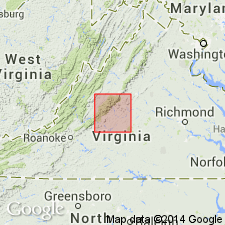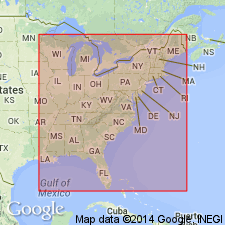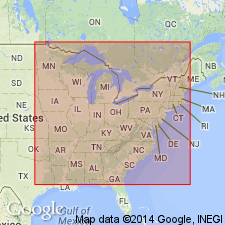
- Usage in publication:
-
- Roseland anorthosite*
- Modifications:
-
- Named
- Dominant lithology:
-
- Anorthosite
- AAPG geologic province:
-
- Piedmont-Blue Ridge province
Summary:
Named Roseland anorthosite for Roseland, Nelson Co., VA. Consists of antiperthitic andesine. It is cut by numerous quartz veins, dikes rich in ferromagnesian minerals, and large lenticular bodies of rock called nelsonite; intrudes gneissic quartz monzonite that forms dominant country rock of the region. Unit has been referred to as pegmatite and syenite by earlier workers. The Roseland is considered to be of Precambrian age.
Source: GNU records (USGS DDS-6; Reston GNULEX).

- Usage in publication:
-
- Roseland anorthosite
- Modifications:
-
- Overview
- AAPG geologic province:
-
- Piedmont-Blue Ridge province
Summary:
Unit used informally on the VA State map. Described as white alkalic anorthosite containing andesine antiperthite megacrysts, blue quartz, and lesser orthopyroxene and rutile. Pervasive cataclastic fabric.
Source: GNU records (USGS DDS-6; Reston GNULEX).

- Usage in publication:
-
- Roseland Anorthosite*
- Modifications:
-
- Geochronologic dating
- AAPG geologic province:
-
- Piedmont-Blue Ridge province
Summary:
Roseland Anorthosite has a Sm-Nd whole rock isochron date of 1045+/-44 Ma, interpreted to be age of crystallization (Pettingill and others, 1984).
Source: GNU records (USGS DDS-6; Reston GNULEX).

- Usage in publication:
-
- Roseland Anorthosite*
- Modifications:
-
- Overview
- AAPG geologic province:
-
- Piedmont-Blue Ridge province
Summary:
On the correlation chart for Precambrian rocks of the conterminous United States, the Roseland Anorthosite of the central and southern Laurentian Appalachians is shown to be of Middle Proterozoic age (1100-1000 Ma).
Source: GNU records (USGS DDS-6; Reston GNULEX).
For more information, please contact Nancy Stamm, Geologic Names Committee Secretary.
Asterisk (*) indicates published by U.S. Geological Survey authors.
"No current usage" (†) implies that a name has been abandoned or has fallen into disuse. Former usage and, if known, replacement name given in parentheses ( ).
Slash (/) indicates name conflicts with nomenclatural guidelines (CSN, 1933; ACSN, 1961, 1970; NACSN, 1983, 2005, 2021). May be explained within brackets ([ ]).

